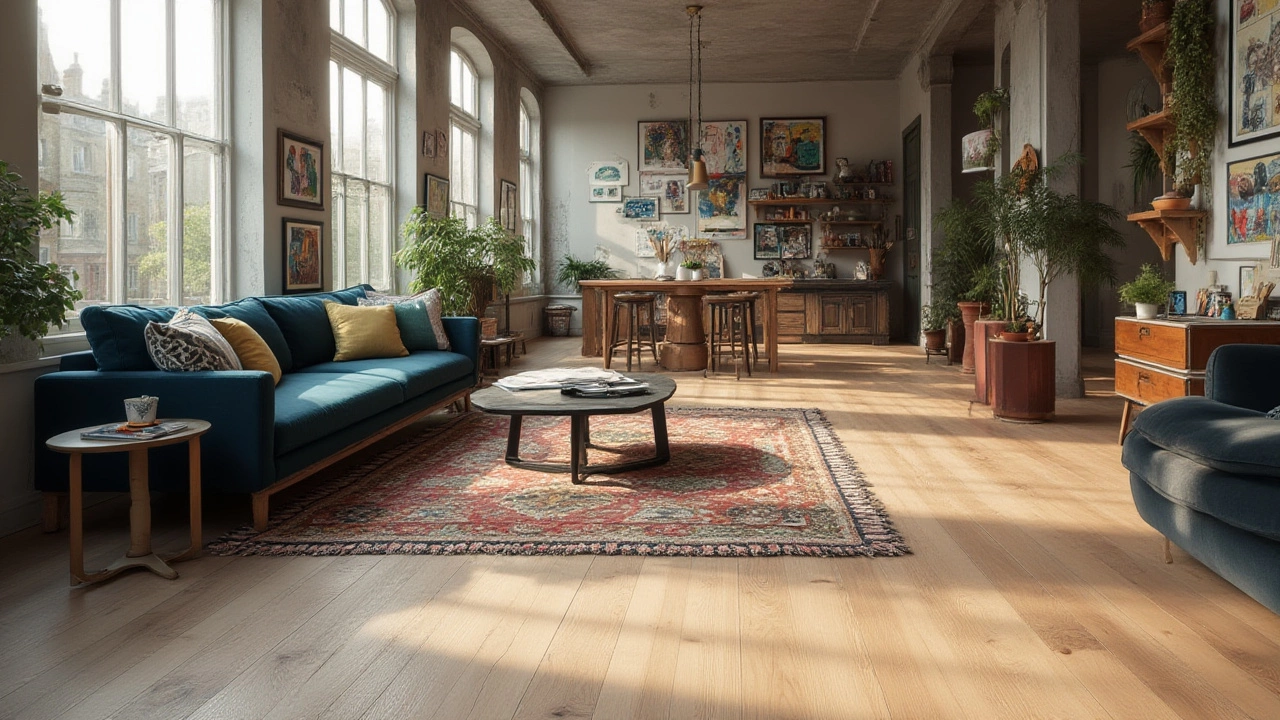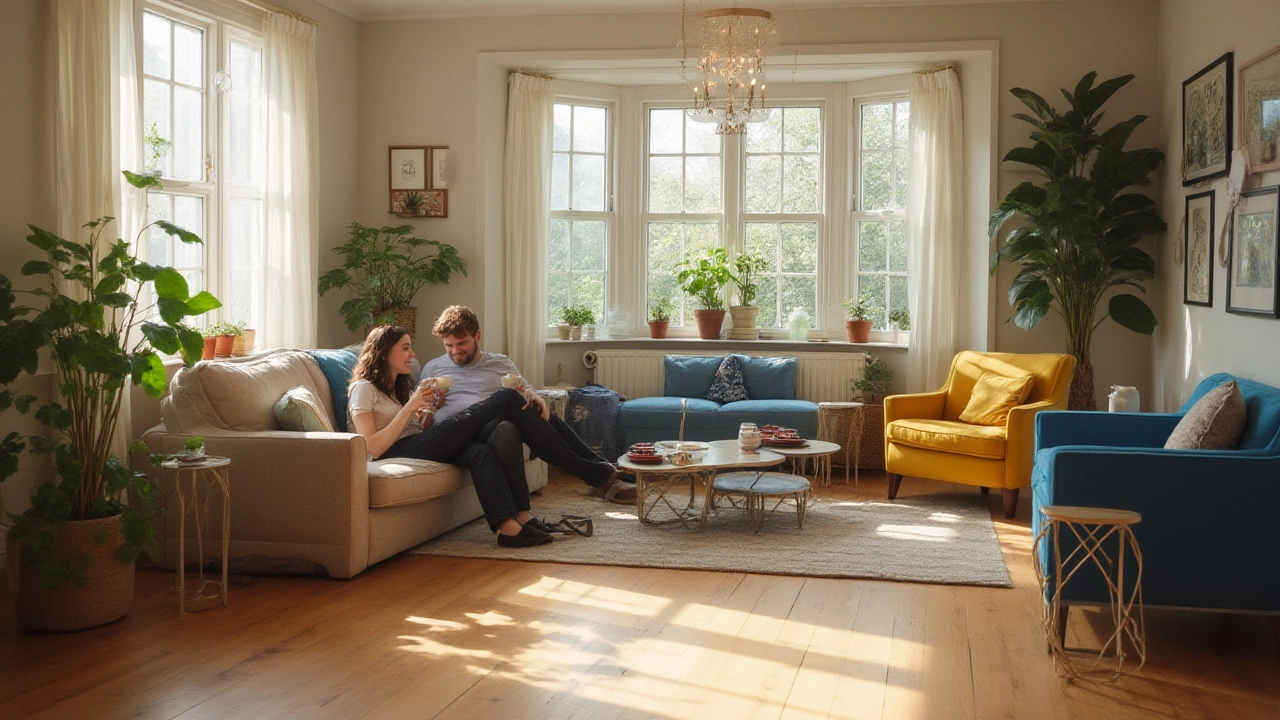Everybody thinks the couch is the living room star. Honestly, flooring steals the show this year. Walk into any open house, and you’ll spot what looks like million-dollar floors under your feet, even if the rest of the place has mystery stains and thrift-store shelves. That’s because floors set the entire vibe for your main hangout space. Right now, two flooring trends have left shag carpets and boring tiles in the dust—making living rooms look sharp, modern, and way more livable than most of us ever imagined.
Engineered Hardwood: Old-School Charm With High-Tech Perks
Hardwood floors used to be a badge of honor, but nobody wants to baby their floors, avoid parties, or panic when their dog so much as thinks about scratching the surface. Enter engineered hardwood—yes, it’s real wood, but smarter. Instead of being one big chunk, it’s built like a sandwich. The top is a thin layer of real, attractive wood (oak, maple, hickory, you name it), sitting on sturdy plywood layers that fight off warping, cupping, and crow’s feet for years or even decades.
Engineered hardwood moves less with changes in humidity and temperature. So, you can install it pretty much anywhere, even over radiant-heat systems or concrete. (Pro tip: solid hardwood over concrete is a nightmare—engineered saves you.) And here’s the kicker—most eyes can’t even tell the difference between engineered and regular hardwood after installation, but your bank account will.
The options are wild now. Wide planks, ultra-matte finishes, super-trendy stains—want light Scandi vibes, moody farmhouse, or old-fashioned brown? There’s a finish. The National Wood Flooring Association dropped stats showing a 35% jump in engineered hardwood sales since 2020. People want real wood, but less hassle.
Don’t forget, engineered wood also plays nice with underfloor heating. That’s a serious bonus if your winters are brutal. It wears well if you’ve got pets or clumsy roommates. There are even types you can refinish once or twice before calling it quits. So, you’re not locked out of later upgrades. Costs range big-time—from $4 to $13 per square foot, depending on wood species, top layer thickness, and bling factor.
But here’s something a lot of folks miss: not all engineered hardwood is waterproof. Water spills are fine if you wipe them up, but—leave a mop puddle overnight and, yeah, you’ll regret it. And cheap brands can chip or delaminate, so watch for warranties and choose a reputable installer. You wouldn’t skimp on sneakers for a marathon, right?
If you want a floor that can anchor a bold accent wall, survive a rowdy game night, and look like a million bucks, engineered hardwood is tough to beat. Want to get the most out of yours?
- Choose a thicker top wood layer—around 3-4mm gives more lifespan if you want to sand it eventually.
- Avoid wet-mopping—it’s not vinyl flooring. Use a microfiber mop or barely damp cloth.
- Get at least a 15-year warranty. The best brands offer up to 50 years (they’re banking on you moving out first).
- Add felt pads under furniture, or you might cry the first time your cousin drags a metal chair across it.
Want some quick data? Here’s how engineered hardwood stacks up in the real world:
| Feature | Engineered Hardwood | Solid Hardwood |
|---|---|---|
| Water Resistance | Moderate (not waterproof) | Low |
| Cost per Sq Ft | $4–$13 | $6–$18 |
| Re-Finishing | 1–2 times (depending on wear layer) | Multiple times |
| Installation | Floating, glue, or nail | Nail or staple only |
| Best For | All rooms, including over concrete/basements | Above-grade rooms, wood subfloors |
Luxury Vinyl Plank (LVP): Surprising Looks, Unbeatable Toughness
If you’ve poked around home stores (or, let’s be honest, TikTok before-and-afters), you’ve noticed an invasion of planks that look like wood but snap together fast—no nails, no Messy Tom DIY disaster stories. That’s Luxury Vinyl Plank (LVP), and it’s everywhere—for a reason.
LVP isn’t your grandma’s yellowing vinyl sheet. It’s a multi-layered fake-wood sandwich: a tough wear layer up top, a high-def printed layer that mimics real wood (seriously, they even print fake knots and grain), usually a rigid core for stability, and a waterproof backing. Spill wine, track in snow, let the dog go wild—it won’t soak, stain, or splinter.
In 2023 alone, industry groups reported that LVP grabbed a 29% market share in residential flooring. Why? It checks every box for busy, not-so-gentle households. It’s waterproof, dent-resistant, and easy on the knees. Big brands have click-lock systems, so even weekend warriors can install it in a day without cursing up a storm. Drop the heavy TV remote, and the floor shrugs it off.
The range of styles is out of control. Want weathered barn wood? Elegant grey tones? Hickory, walnut, or…marble? (No one’s judging.) The technology is so advanced some designs even feel textured. If you host all the get-togethers, or have kids who treat the living room like a racetrack, LVP is basically disaster-proof.
There are a couple of tips that make life easier when you’re shopping for LVP. First, thickness matters. Look for planks with a minimum 12mil wear layer; if you’ve got a house full of pets or active kids, 20mil is better. Second, don’t skip an underlayment if you want that extra-comfy feel and quieter footsteps. Some LVP comes with a built-in underlayment—bonus points for easy install!
LVP floats over most existing floors—concrete, tile, plywood, even an aging laminate—as long as the surface is flat. And if a plank somehow does get ruined? Pop it out and replace it, no sweat. It’s low-stress living, man.
- Waterproof—perfect for soggy climates or party houses
- Low maintenance—no sanding, no special cleaners, just a broom and a mop
- Pet- and kid-friendly—claws, spills, dropped toys are all fair game
- Huge style variety—matches any design scheme, from boho to ultra-modern
Here are numbers worth knowing when weighing whether LVP is your living room hero:
| Feature | Luxury Vinyl Plank | Laminate Flooring |
|---|---|---|
| Waterproof | Yes | No (some water-resistant options) |
| Life Expectancy | 10–20 years | 8–15 years |
| DIY Friendly | Yes (click-lock) | Yes (click-lock) |
| Cost per Sq Ft | $2–$7 | $1–$5 |
| Best for Pets & Kids | Excellent | Good |
LVP’s only real downside is that it’s not real wood—if you want to boost resale value in a historic area, it won’t impress hardcore traditionalists. But for most of us, *living room flooring* that can laugh off red wine and muddy boots is worth its weight in gold.

Making the Choice: Lifestyle, Look, and Longevity
Nobody wants to rip up their living room again in a few years, so picking your floor isn’t just about what’s hot on Instagram. It’s what works for you, every day. Engineered hardwood and LVP both hit that sweet spot where style meets practicality, but some lifestyles and room setups will steer you to one over the other faster than you’d expect.
Think about your life right now—and for the next five years. Maybe you crave the feel and smell of real wood, plus you host wine-and-cheese nights for your circle of friends. Engineered hardwood nails that sophisticated vibe and can be refinished if it gets dinged. On the flip side, if your idea of happy hour is epic dog zoomies, wild birthday parties, or daily chaos, luxury vinyl plank will never tattle about what happened on its watch.
If sustainability is on your mind, engineered wood is the greener pick. The plywood core uses less slow-growing hardwoods, and many brands offer low-VOC finishes. Still, LVP has improved—look for phthalate-free and FloorScore-certified brands if VOCs worry you.
Color and plank width trends change fast, but for 2025, wider planks and lighter wood tones are leading the charge in both options. Villa-inspired and nature-inspired shades are “it”—think pale oak, faded greige, and those breezy, sun-bleached looks from design magazines. Want to future-proof your pick? Go with a neutral mid-tone, skip the orange-browns, and find something you genuinely like.
If budget isn’t bottomless, you’ll probably see a sharp price gap: LVP is the best bang for your buck, especially if you tackle the job DIY. Engineered hardwood is pricier up front, but it might swing higher resale value if you plan on selling down the road. A 2024 homebuyer survey from the National Association of Realtors found 77% of buyers put “hardwood or high-end lookalike” on their must-have lists, so you’re not going wrong.
Here’s one thing that’s crucial—don’t skimp on subfloor prep. Squeaks, soft spots, or waves in your floor can wreck even the slickest install. Professionals can level concrete, check for moisture problems, and give you the advice you didn’t know you needed. And always order at least 10% extra—cuts and bad boards happen, and no one wants a mismatched patch mid-living room because the style went out of stock.
- If you want changeable style, LVP is easier to replace in the future—no need to redo the whole floor.
- Allergy-prone? Both types are way better than carpet, but double-check finishes for low off-gassing.
- Watch for warranties (lifetime is ideal for LVP, 20+ years for engineered wood)—they matter if something goes sideways, and are proof of quality.
- If you use area rugs, always get non-slip pads that are safe for your floor type—some rubber can yellow vinyl, and harsh pads scratch wood.
- Want a quiet room? Pair with cork or high-end foam underlayment—your floors will be the strongest, quietest thing in the house (besides your opinions).
Your living room should feel like you—stylish, welcoming, and ready for whatever the day throws your way. These two flooring choices set the scene, whether your scene is kids building blanket forts or adults sipping cocktails. Either way, it’s the best time in decades to trade tired carpet for something your feet—and your eyes—will thank you for.
Quick Tips: Getting Your Dream Floor Without Regret
You’re about to spend real money (and time) on flooring, so smart shortcuts help dodge mistakes nobody brags about. Here’s what savvy folks do that others forget:
- Ask for take-home plank samples under natural daylight. It blows your mind how different they look from the store.
- Read online reviews, but don’t just skim the top five—dig for people who had your kind of chaos. If their floor survived, it’s a keeper.
- Call the local installer before you order. They’ll warn you about brands with shipping issues or fussy click-lock systems for your subfloor.
- Don’t just lay floors parallel to the long wall. Sometimes, switching direction makes the room feel wider or hides door-to-window seams better.
- Test for squeaks by tapping a plank after install, before moving in all your heavy stuff—fixing a squeak under the couch is a pain you don’t want.
If you’ve been staring at worn-out carpet, scratchy laminate, or floors that just make the room feel dated, there’s never been a better time to bounce into something fresh. Engineered hardwood amps up elegance, while luxury vinyl plank is worry-free and looks the part. Bedrooms have trends, but living rooms need heart—and strong, good-looking floors are where you start.
